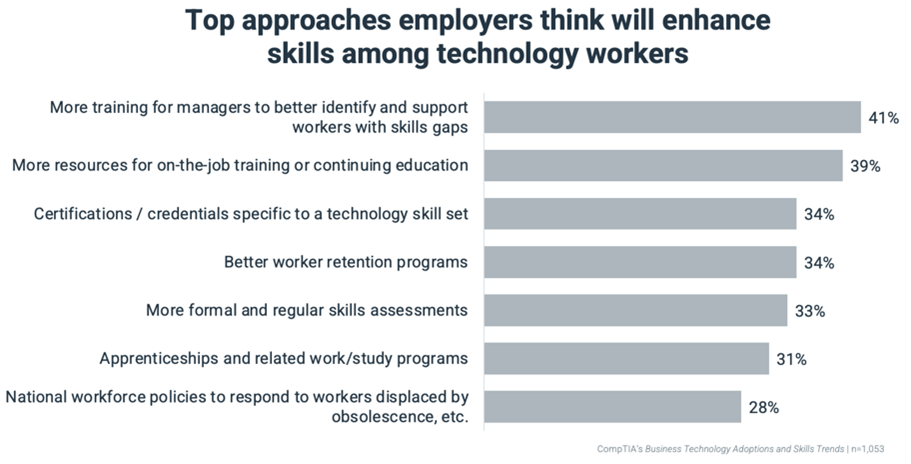
Technology is integral for the success of all types of businesses. We continue to see that technology is most often optimized when people and policies as well as processes are all in alignment with business objectives. This holds true across all types of organizations around the globe.
Close to three-quarters of executives and other qualified professionals in CompTIA’s international Business Technology Adoption and Skills Trends report that technology indeed plays a primary role in meeting their business objectives. While most of the remainder would rate it more so as a secondary factor, and very few a non-factor.
As one may expect, the larger the company size, the greater the reliance on technology for achieving business objectives. Furthermore, firms in the technology sector itself, as well as those in finance, banking or insurance, also tend to indicate that technology is a primary factor at significantly greater rates versus those in other sectors such as government or education.
Nonetheless, it’s interesting to see how outside circumstances endured the last two-plus years drastically shifted the way many academic institutions, for instance, utilized technology and continue to do so moving forward. And how already tech savvy firms may focus more on strategic initiatives and the other key pieces, i.e., people, policies and processes.
Technology Still Key in Finding New Customers, Markets and Employees
The top business priorities identified by the executives in CompTIA’s study across seven countries include building greater operational efficiencies, enhancing employee skills, and innovation. While technology may be more directly tied to certain initiatives such as implementing new systems to enhance efficiencies, it still holds an important role with others including identifying new customers and markets, hiring or developing skills, etc.
Tech service firms are also crucial to the success of clients worldwide. Sometimes organizations turn to outside expertise for technology solutions when they need to focus on other core competencies. According to CompTIA’s international study, nearly 6 in 10 organizations report using outsourced tech firms often or on a regular basis (57%), another 3 in 10 occasionally (29%).
The top types of tech services outsourced include tech consulting; cloud related; cybersecurity; software, web or app development; and troubleshooting, repair or maintenance related. Interestingly, firms that outsource more often tend to report higher perceptions of ROI from their tech investments. Regardless of outsourcing status though, top reasons cited for below average or disappointing ROI of tech investments to be aware of include ongoing maintenance costs; staff time requirements to operate/maintain; upfront cost; complexity/poor user experience; and required upgrades.
Demand for Tech Still Fuels Need for More Skilled Talent
More and more, employers are increasing efforts on all fronts to attain the tech workforce and skills they need themselves. That comes from hiring new employees as well as developing current talent. Fortunately, tech workers especially have an appetite for those continuous learning and professional development opportunities. But the tech talent pipeline needs fortifying. Current supply is not keeping up with demand. Hence, CompTIA’s Project Agora recently announced initiative aimed at converting more career intent people to tech intent.

Employers around the globe need to innovate, but in the ways that work best for them. Consider first where they want to be, then how to get there successfully. For some that will be partnering with a tech services firm. For others, perhaps an enhanced use of certain emerging technologies (e.g., virtual reality for a more engaging method of learning, robotic process automation for candidate screening), new career development resources (e.g., training aligned with career development goals, cross-functional training), gaining access to a more diverse pool of candidates (e.g., increasing focus on skills and performance rather than degrees, implementing an apprenticeship program), etc. In any case, it's imperative that employers are agile as workforce needs and organizational priorities continue to evolve.
CompTIA’s Business Technology Adoption and Skills Trends was conducted to collect and share information on technology adoption and workforce trends across several countries including Australia, Germany, Japan, Netherlands, Singapore, United Kingdom, and United States. A total of 1,053 qualified technology and business executives and professionals participated in the quantitative study via online survey fielded during July 2022. Access the full report here and attend the CompTIA EMEA Member and Partner Conference to learn more about industry trends.
Amy Carrado is senior director, market research and intelligence, at CompTIA.
Want to learn more?
Check out Student Perspectives of Technology and Careers

 Add CompTIA to your favorite RSS reader
Add CompTIA to your favorite RSS reader

